How to Write Horror: The Basics of Crafting Terror
How to Write Horror: The Basics of Crafting Terror
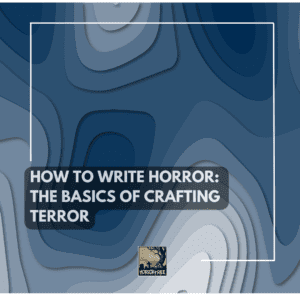
Welcome, brave authors, to the thrilling world of horror writing! While it might seem like a dark and twisted genre, it is one that has captivated readers and audiences for centuries. Horror has found its way into literature, movies, television, and even video games, proving that the appeal of being scared is not only universal but also enduring. As an aspiring horror writer, you have the unique opportunity to make your readers’ hearts race, their palms sweat, and their minds race with chilling questions.
One of the keys to writing successful horror stories lies in understanding the psychology of terror. By delving into the depths of human fears, you can create gripping and immersive narratives that resonate with your audience on a primal level. This article will serve as your guide to the basics of crafting terror, providing you with the essential tools and techniques to make your stories truly unforgettable.
As you venture further into the realm of horror writing, remember that you are not alone in your journey. Countless authors before you have faced the challenge of instilling fear into their readers, and their timeless works continue to inspire and instruct new generations of writers. So, let us begin our exploration of the art of horror, and may your creative spirit soar as you breathe life into the nightmares that will haunt your readers’ dreams.
The Psychology of Fear and Terror:
Fear and terror are complex emotions that are deeply rooted in our human psyche. To craft an effective horror story, it’s important to understand the various psychological aspects of these emotions and how they can be used to captivate readers.
Innate and Learned Fears:
Innate fears are hardwired into our brains as a result of evolution. These include fears of the dark, heights, and dangerous animals, among others. Learned fears, on the other hand, are developed through personal experiences and cultural influences. As a writer, you can tap into both types of fears to create a well-rounded horror experience.
- Example: H.P. Lovecraft’s “The Call of Cthulhu” plays on innate fears of the unknown and cosmic insignificance, while Stephen King’s “It” capitalizes on common learned fears, such as clowns and childhood traumas.
The Fear of the Unknown:
Uncertainty and unpredictability are major drivers of fear. By keeping readers in the dark about certain aspects of your story, you can build anticipation and dread, making the eventual reveal more impactful.
- Example: Shirley Jackson’s “The Haunting of Hill House” creates an atmosphere of uncertainty around the supernatural occurrences, leaving readers questioning whether the events are real or imagined.
The Power of Imagination:
Often, what we imagine is far scarier than what we actually see. Playing with your readers’ imaginations by providing subtle hints and suggestions can make your story more terrifying than if you were to describe everything in detail.
- Example: In “The Turn of the Screw” by Henry James, the ghosts are never explicitly described, allowing readers to conjure their own horrifying images.
The Role of Empathy:
Readers become more invested in a story when they can empathize with the characters. By creating relatable, well-developed characters, you can make your readers feel more connected to their fears and experiences.
- Example: In “The Shining” by Stephen King, Jack Torrance’s descent into madness is made all the more terrifying because readers can empathize with his struggles as a father and husband.
As a horror writer, understanding and exploiting these psychological aspects of fear and terror can help you create a truly immersive experience for your readers. By tapping into universal fears, manipulating the unknown, allowing readers’ imaginations to run wild, and fostering empathy for your characters, you can evoke powerful emotions that will make your story unforgettable.
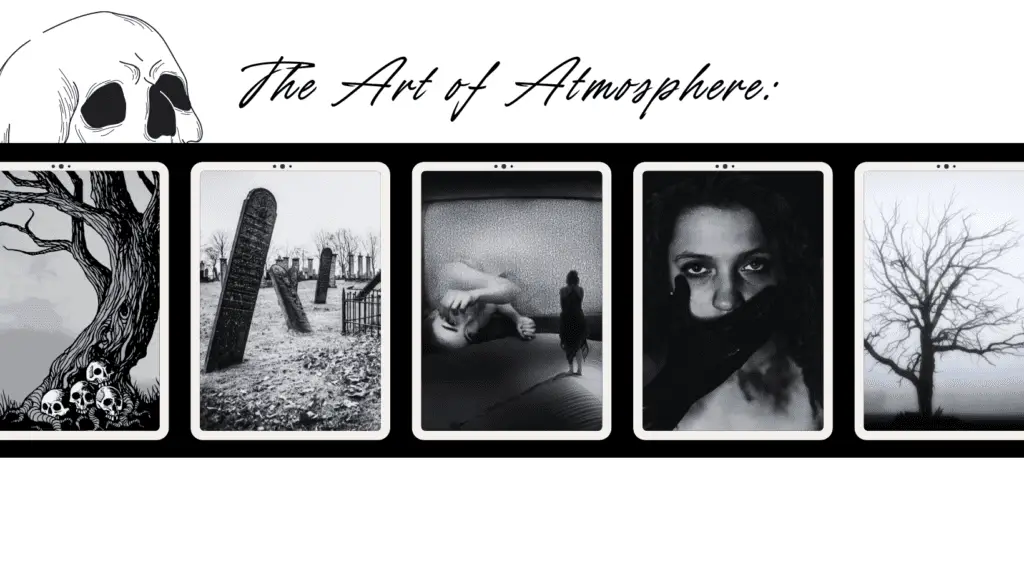
The Art of Atmosphere:
In horror, setting and atmosphere are crucial elements that help create an immersive and unsettling experience for the reader. A well-crafted atmosphere can evoke a sense of dread and unease, making the story feel more realistic and heightening the impact of the terrifying events that unfold. Here, we’ll discuss the importance of setting and atmosphere in horror, along with tips on how to build tension and unease through description and mood.
Choosing the Right Setting:
The setting is the backdrop against which your story takes place and can significantly influence the overall mood and tone. When crafting a horror story, consider selecting a setting that lends itself to suspense, isolation, and vulnerability. Classic horror settings include haunted houses, desolate landscapes, and remote locations.
- Example: In “The Woman in Black” by Susan Hill, the isolated Eel Marsh House, surrounded by treacherous marshlands, enhances the sense of dread and vulnerability.
Descriptive Language and Imagery:
Use vivid descriptions and sensory details to paint a picture of your setting, enabling your readers to visualize the environment and feel like they are part of the story. Be mindful of your word choices, opting for adjectives and phrases that evoke a sense of unease, darkness, or decay.
- Example: Edgar Allan Poe’s “The Fall of the House of Usher” features rich, gothic descriptions that contribute to the story’s eerie atmosphere.
The Power of Weather and Time:
Weather and time of day can be used to heighten tension and create an ominous atmosphere. Stormy weather, fog, and darkness can all contribute to a sense of foreboding, making events in your story feel more menacing.
- Example: In Bram Stoker’s “Dracula,” the stormy weather and nighttime scenes add to the sense of danger and impending doom.
Subtle Foreshadowing:
Incorporate subtle hints and foreshadowing to build anticipation and keep your readers on edge. This can be done through descriptions of the setting or through the characters’ observations and feelings. Be careful not to overdo it, as being too obvious can detract from the suspense.
- Example: In Shirley Jackson’s “We Have Always Lived in the Castle,” the ominous atmosphere is built through subtle foreshadowing and the narrator’s unsettling descriptions of their family home.
Pacing and Rhythm:
The pacing and rhythm of your narrative can contribute to the atmosphere and tension in your story. Slower pacing allows for more detailed descriptions and a gradual build-up of tension, while faster pacing can create a sense of urgency and disorientation.
- Example: In “Psycho” by Robert Bloch, the pacing and rhythm contribute to the story’s suspenseful atmosphere, keeping readers on edge as they uncover the dark secrets of the Bates Motel.
By carefully considering your setting, utilizing descriptive language and imagery, employing weather and time to create tension, incorporating subtle foreshadowing, and managing pacing and rhythm, you can craft an atmosphere that is both haunting and unforgettable. Remember, a well-crafted atmosphere can significantly enhance the horror experience, making your story all the more chilling and memorable.
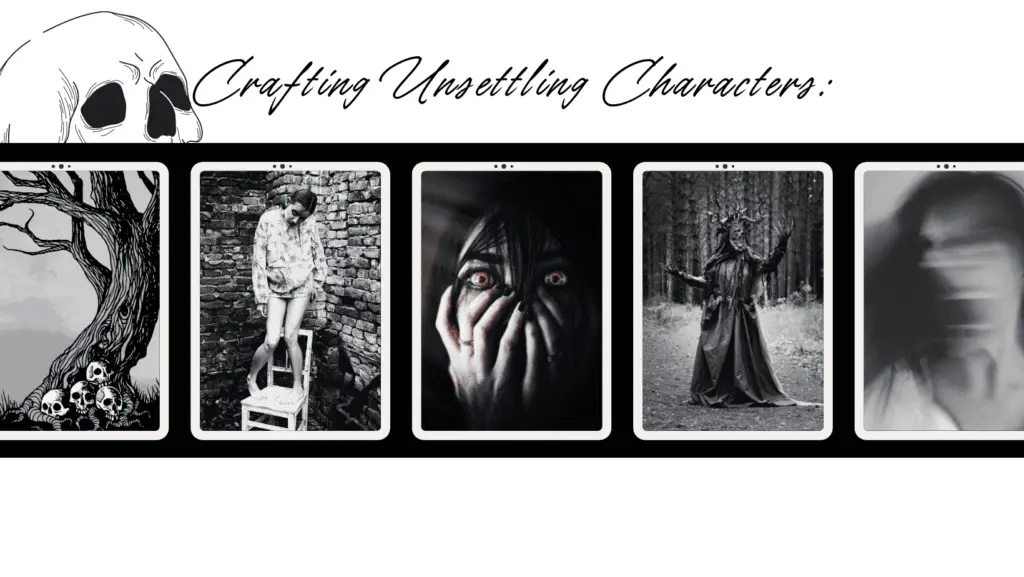
Crafting Unsettling Characters:
Characters play a crucial role in any story, and in horror, they can be the driving force behind the terror and intrigue. Both heroes and villains have important roles to play, and crafting multi-dimensional characters can make your story more engaging and emotionally resonant. In this section, we’ll discuss the roles of heroes and villains in horror stories and provide guidance on creating characters that evoke sympathy and dread.
The Role of Heroes:
Heroes, or protagonists, in horror stories often serve as the reader’s anchor in the unsettling world you create. They are the ones the readers root for, identify with, and fear for as they face horrifying obstacles. A well-developed hero should be relatable, vulnerable, and flawed, which allows readers to empathize with their struggles and feel emotionally invested in their journey.
- Example: In “Rosemary’s Baby” by Ira Levin, the protagonist, Rosemary, is a sympathetic and relatable character who finds herself caught in a terrifying web of conspiracy and supernatural danger.
The Role of Villains:
Villains, or antagonists, are the source of the horror and conflict in your story. They can be supernatural entities, deranged humans, or even manifestations of psychological trauma. An effective villain should evoke fear and dread, while also being complex and intriguing. By providing your villain with a backstory or motivation, you can create a more nuanced and compelling character.
- Example: In “Silence of the Lambs” by Thomas Harris, Dr. Hannibal Lecter is a captivating and terrifying villain whose intellect and cannibalistic tendencies create a chilling sense of dread.
Balancing Sympathy and Dread:
To create truly unsettling characters, strive to strike a balance between evoking sympathy and dread. Give your heroes flaws and vulnerabilities, which make them more relatable and intensify the reader’s concern for their well-being. For your villains, consider adding elements of humanity or understandable motives, which can make them more complex and disturbing.
- Example: In “Frankenstein” by Mary Shelley, both Dr. Frankenstein and his monstrous creation evoke a mix of sympathy and dread, as their actions stem from relatable emotions and desires, yet lead to horrifying consequences.
Character Development and Arcs:
Both heroes and villains should undergo development throughout the story, making them feel more dynamic and real. This can include facing their fears, overcoming personal obstacles, or succumbing to the darkness. Creating compelling character arcs not only makes your story more engaging, but it also intensifies the emotional impact of the horror.
- Example: In “The Exorcist” by William Peter Blatty, both the possessed Regan and the doubting priest, Father Karras, undergo significant character development, making their struggles all the more harrowing.
By crafting multi-dimensional heroes and villains that evoke both sympathy and dread, you can create a more immersive and emotionally charged horror experience for your readers. Remember, your characters are the heart of your story, and investing time and effort in their development will make your horror story all the more powerful and memorable.
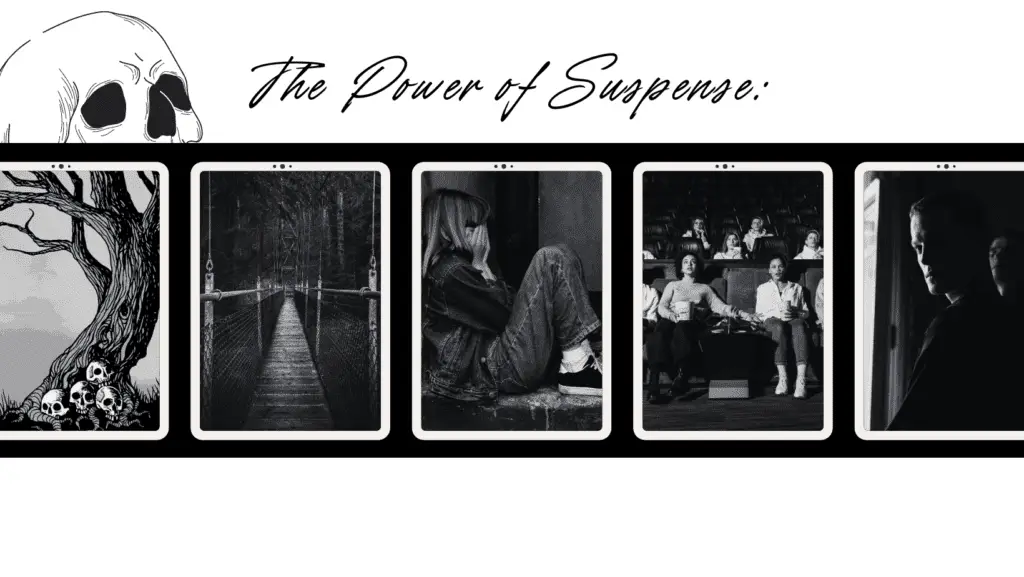
The Power of Suspense:
Suspense is the feeling of anticipation and uncertainty that keeps readers on edge and emotionally invested in a story. It plays a vital role in horror storytelling, as it heightens tension and makes the eventual scares and twists more impactful. Suspense keeps readers hooked, turning the pages to find out what happens next, while also fostering a sense of dread and unease. In this section, we’ll explore techniques for building suspense in your horror story through pacing, foreshadowing, and misdirection.
Pacing:
Pacing is the speed at which your story unfolds and can greatly influence the level of suspense. By varying the pacing of your narrative, you can control the intensity of the suspense and keep readers engaged. Slower pacing allows for gradual tension-building and deeper character development, while faster pacing can create a sense of urgency and escalate the stakes.
- Example: In “Bird Box” by Josh Malerman, the pacing alternates between the tense present-day narrative and slower-paced flashbacks, creating a balance of suspense and character development.
Foreshadowing:
Foreshadowing is the technique of providing subtle hints or clues about future events in your story. When used effectively, foreshadowing can build suspense by creating anticipation and making readers eager to find out what happens next. Be cautious not to make your foreshadowing too obvious, as this can diminish the impact of your story’s twists and scares.
- Example: In “Rebecca” by Daphne du Maurier, the opening line foreshadows the story’s dark and tragic events, creating a sense of foreboding that permeates the novel.
Misdirection:
Misdirection involves leading readers to believe something will happen, only to reveal later that something entirely different has taken place. This technique keeps readers guessing and heightens the suspense by making them question their assumptions and expectations. Misdirection can be achieved through unreliable narrators, red herrings, or unexpected plot twists.
- Example: In “Gone Girl” by Gillian Flynn, the story employs misdirection through its dual narrative structure and unreliable narrators, keeping readers uncertain about the truth and constantly guessing what will happen next.
Cliffhangers and Unresolved Tension:
Ending a chapter or scene with a cliffhanger or unresolved tension can effectively build suspense by leaving readers eager to find out what happens next. By withholding crucial information or resolution, you encourage readers to continue reading and maintain their emotional investment in the story.
- Example: In “The Haunting of Ashburn House” by Darcy Coates, the author employs numerous cliffhangers and moments of unresolved tension, keeping readers on edge and eager to uncover the house’s dark secrets.
By mastering the art of suspense through pacing, foreshadowing, and misdirection, you can create a truly gripping horror story that keeps readers on the edge of their seats. Suspense is a powerful tool in horror storytelling, and when used effectively, it can elevate your story from a simple scare to a chilling and unforgettable experience.
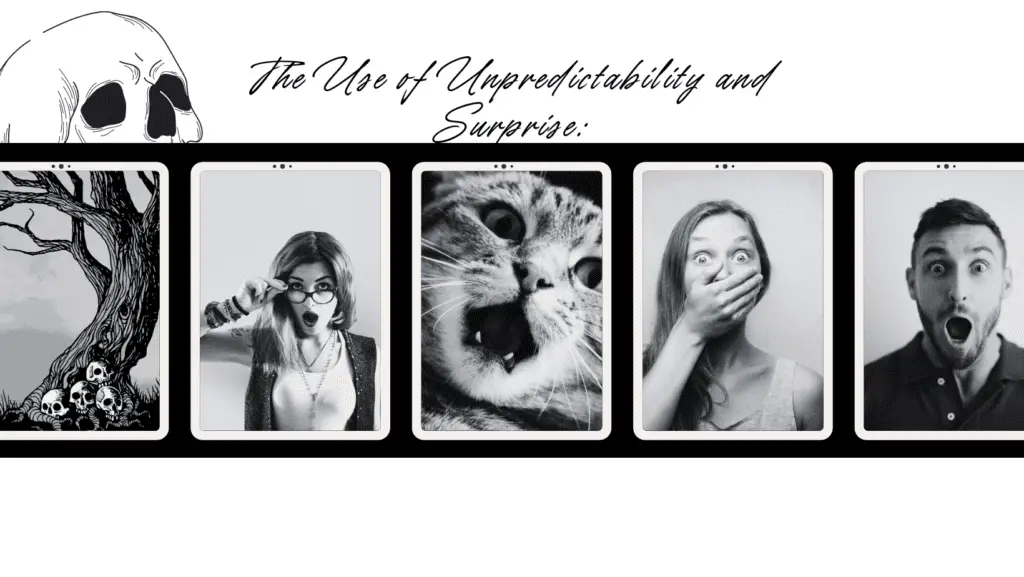
The Use of Unpredictability and Surprise:
Unpredictability and surprise are key elements in horror storytelling, as they can keep readers engaged, heighten suspense, and create memorable moments of shock and terror. By subverting expectations and introducing surprising twists, you can keep your readers guessing and make your story more impactful. In this section, we’ll discuss the importance of unpredictability and surprise in horror and offer tips on how to subvert expectations and create shocking twists.
Subverting Tropes and Clichés:
One way to create unpredictability in your horror story is to subvert established tropes and clichés. By deviating from the expected norms of the genre, you can surprise readers and make your story feel fresh and original. Consider taking familiar horror scenarios or character types and putting your own unique spin on them.
- Example: In “The Cabin at the End of the World” by Paul Tremblay, the author subverts the classic “cabin in the woods” horror trope by introducing unexpected elements and an ambiguous, thought-provoking plot.
Unreliable Narrators:
Utilizing unreliable narrators can be an effective way to create unpredictability in your story. By having a character whose perspective or account of events is not entirely trustworthy, you can keep readers guessing and lead them to question what is truly happening in your narrative.
- Example: In “The Silent Patient” by Alex Michaelides, the use of an unreliable narrator keeps the reader uncertain about the truth behind the protagonist’s actions and the events that transpire, ultimately leading to a shocking twist.
Unexpected Plot Twists:
Introducing unexpected plot twists can not only surprise readers but also increase the emotional impact of your story. When crafting plot twists, ensure they are well-executed and logical within the context of your narrative. Be cautious not to rely too heavily on twists, as this can make your story feel gimmicky or contrived.
- Example: In “I’m Thinking of Ending Things” by Iain Reid, a series of unexpected plot twists leaves readers questioning the nature of the story’s reality and creates an unsettling sense of unease.
Shifting Perspectives and Timelines:
Experimenting with different narrative perspectives or non-linear timelines can add an element of unpredictability to your horror story. By revealing events or character insights out of order, you can keep readers on their toes and create a sense of disorientation or confusion that complements the horror elements.
- Example: In “Slade House” by David Mitchell, the story unfolds through multiple narrative perspectives and time periods, gradually revealing the horrifying truth behind the mysterious house and its inhabitants.
By embracing unpredictability and surprise in your horror storytelling, you can create a more engaging and memorable reading experience for your audience. Whether through subverting tropes, employing unreliable narrators, crafting unexpected plot twists, or experimenting with narrative structure, the element of surprise can elevate your horror story and leave a lasting impact on your readers.
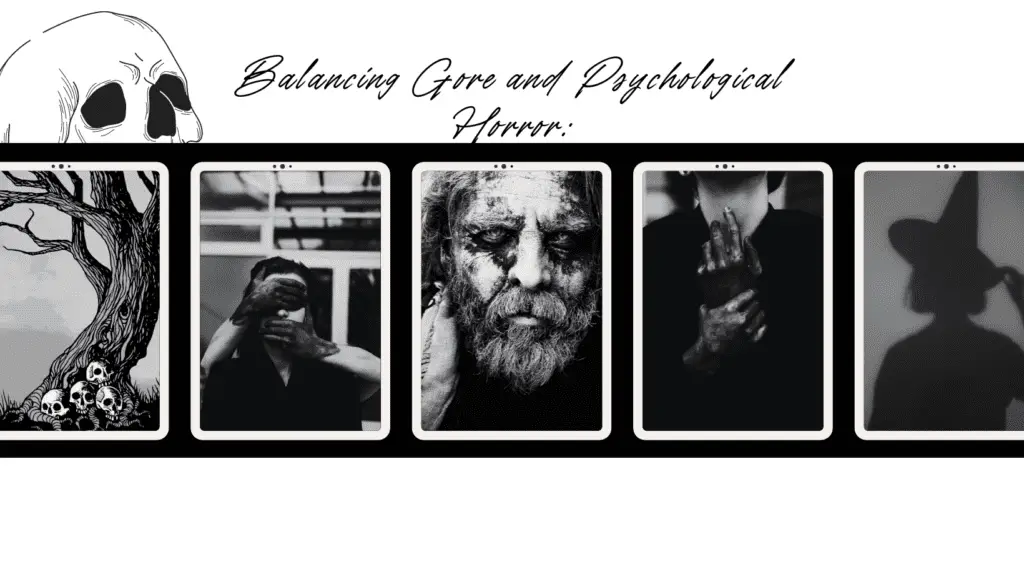
Balancing Gore and Psychological Horror:
Horror fiction often grapples with the balance between graphic violence and gore, and more subtle, psychological horror. Both can be powerful tools for evoking fear and unease in readers, but their effectiveness depends on the story you are trying to tell and the preferences of your target audience. In this section, we’ll discuss the role of violence and gore in horror fiction, provide guidance on when to use graphic imagery, and explore the benefits of leaving some things to the reader’s imagination.
The Role of Violence and Gore:
Violence and gore can serve various purposes in horror fiction, from shocking and repulsing readers to underscoring the stakes and consequences faced by the characters. Graphic imagery can create a visceral, immediate response in readers, heightening the impact of a scene or plot point. However, it’s important to use violence and gore judiciously, as excessive or gratuitous depictions can desensitize readers or detract from the story’s emotional impact.
- Example: In “American Psycho” by Bret Easton Ellis, the graphic violence and gore serve to illustrate the protagonist’s descent into madness and the horror of his actions.
Psychological Horror and Imagination:
In contrast to gore, psychological horror relies more on suggestion, atmosphere, and the power of the reader’s imagination. By leaving certain elements ambiguous or unexplained, you can create a sense of unease and dread that lingers in the reader’s mind long after they’ve finished your story. Psychological horror often explores themes of fear, isolation, and the darker aspects of the human psyche.
- Example: In “The Turn of the Screw” by Henry James, the psychological horror stems from the ambiguity surrounding the supernatural occurrences and the reliability of the narrator, allowing readers to draw their own conclusions about what is truly happening.
Striking the Right Balance:
When deciding whether to use graphic violence or psychological horror, consider the tone and theme of your story, as well as your intended audience. Some horror stories benefit from a focus on gore, while others are better served by subtler, psychological elements. Be mindful of your audience’s preferences, and use gore and violence to enhance your story, rather than relying on shock value alone.
- Example: In “The Shining” by Stephen King, the author strikes a balance between visceral horror and psychological tension, combining graphic violence with the exploration of the protagonist’s deteriorating mental state.
When to Use Graphic Imagery:
Use graphic imagery when it serves a purpose in your story, such as highlighting the consequences of a character’s actions or intensifying a scene’s emotional impact. Avoid using gore for shock value alone, as this can be off-putting to some readers and may detract from your story’s overall effectiveness.
- Example: In “Carrie” by Stephen King, the graphic violence during the climactic scene serves to emphasize the tragic consequences of the protagonist’s unleashed power and the culmination of her torment.
By understanding the roles of both gore and psychological horror in storytelling, you can strike the right balance for your specific narrative and audience. Remember, horror is a diverse genre that can accommodate a wide range of styles and preferences, and the key to crafting an effective, chilling tale lies in finding the approach that best suits your story and resonates with your readers.
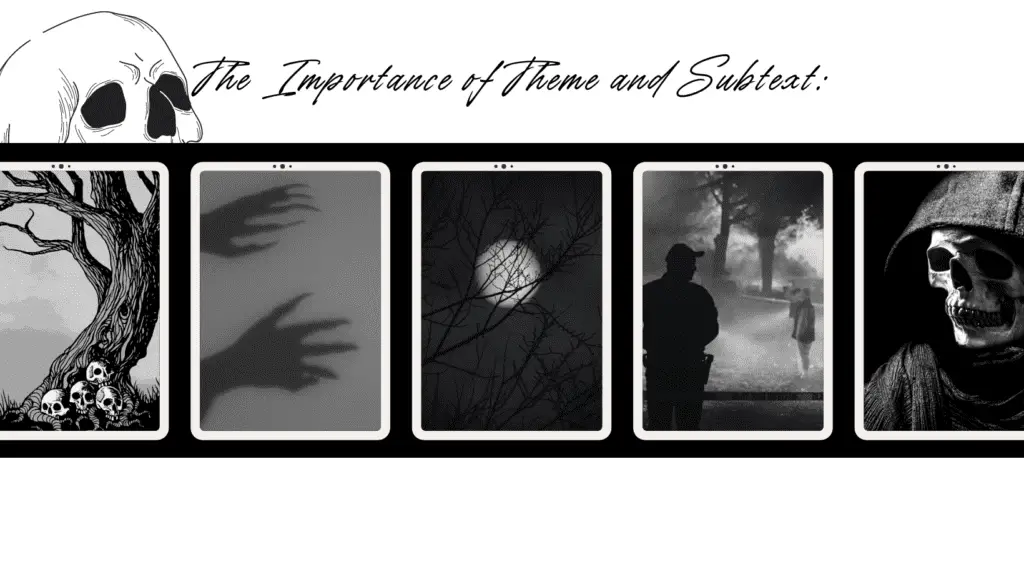
The Importance of Theme and Subtext:
In addition to evoking fear and unease, the most memorable horror stories often explore deeper themes and subtext, adding layers of meaning and resonance to their narratives. Themes and subtext can provide a foundation for your story, giving it substance beyond surface-level scares and allowing readers to connect with the narrative on a more profound level. In this section, we’ll discuss the role of deeper themes and subtext in elevating horror stories and offer examples of common horror themes and how to incorporate them into your writing.
The Role of Theme and Subtext:
Themes and subtext are the underlying messages or ideas that permeate a story, adding depth and nuance to the narrative. By exploring themes relevant to the human experience, you can create a horror story that transcends mere entertainment and encourages readers to reflect on deeper issues. This not only makes your story more engaging but also helps it to resonate with a wider audience.
- Example: In “The Lottery” by Shirley Jackson, the story explores themes of conformity, tradition, and the dark side of human nature, making it a thought-provoking and chilling tale.
Common Horror Themes:
Horror fiction often tackles universal themes that tap into readers’ deepest fears and concerns. While not nearly a full list, some common themes in horror stories include:
Fear of the unknown:
Horror stories often exploit our innate fear of the unknown, whether it’s the darkness that lies beyond the edge of our flashlight or the mysteries of the human mind.
Loss of control:
Many horror stories revolve around a character’s loss of control over their circumstances, their body, or their mind.
Isolation:
Horror stories frequently explore the theme of isolation, both physical and psychological, as characters find themselves cut off from the rest of society or even their own sanity.
Death and the Afterlife:
The fear of death and the unknown that lies beyond it is a recurring theme in horror fiction.
Incorporating Themes into Your Writing:
When incorporating themes and subtext into your horror story, consider how they can inform your plot, characters, and setting. Use your chosen theme to guide your story’s development and add depth to the narrative. Keep in mind that themes and subtext should be subtle and not overly didactic; allow readers to discover and interpret the underlying meaning on their own.
- Example: In “The Haunting of Hill House” by Shirley Jackson, the theme of isolation is explored through both the physical setting and the protagonist’s psychological state, creating a sense of unease that permeates the narrative.
By exploring deeper themes and subtext in your horror story, you can elevate your narrative beyond simple scares and create a more meaningful and engaging reading experience. Remember, the most impactful horror stories are those that tap into the fears and concerns that lie beneath the surface, resonating with readers on a profound level and leaving a lasting impression.
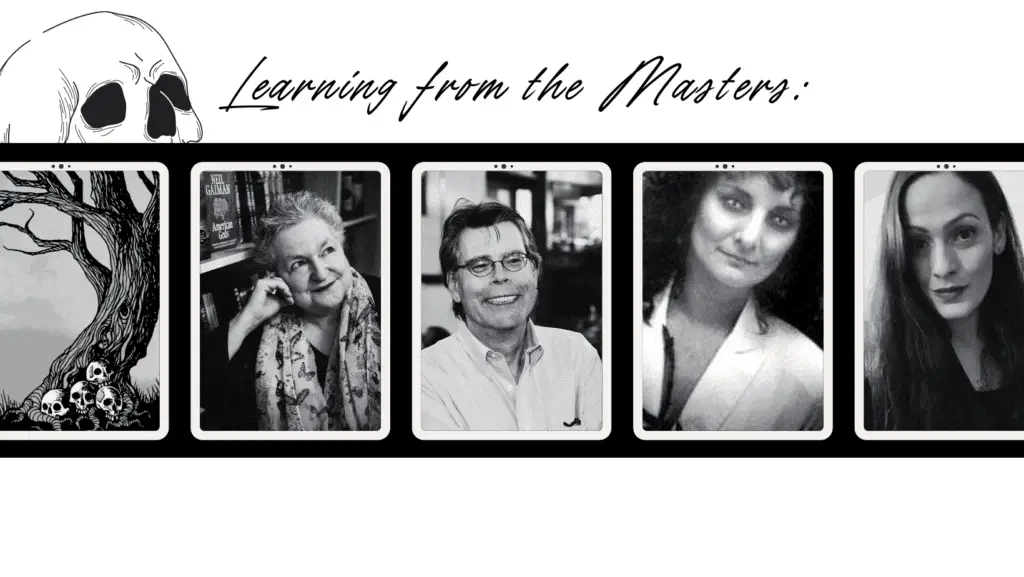
Learning from the Masters:
Studying the works of influential horror authors can provide invaluable insight into the craft of horror writing, helping you understand what makes their stories so effective and resonant. By analyzing the techniques and strategies employed by these masters of the genre, you can hone your own skills and develop a unique voice in your horror storytelling. In this section, we’ll discuss the works of influential horror authors, offer tips on how to study and learn from the greats in the genre, and share some encouraging advice from these authors to help you get into the right mindset.
Influential Horror Authors:
Some of the most influential horror authors whose works have shaped the genre include:
- Edgar Allan Poe: A master of atmosphere and suspense, Poe’s macabre tales delve into the darkest recesses of the human psyche.
- H.P. Lovecraft: Lovecraft’s cosmic horror explores themes of insignificance, fear of the unknown, and the vast, incomprehensible universe that surrounds us.
- Shirley Jackson: Known for her chilling, psychological horror, Jackson’s stories often explore themes of isolation, societal pressure, and the dark side of human nature.
- Stephen King: A prolific and popular horror author, King’s work spans a variety of horror subgenres, delving into themes of fear, loss, and the power of love and friendship.
Studying the Greats:
To learn from these influential horror authors, consider the following strategies:
- Read widely: Read a variety of works from different horror authors and subgenres, paying attention to the techniques and storytelling devices they use to create tension, atmosphere, and terror.
- Analyze their techniques: Break down the elements that make these authors’ works so effective, such as pacing, character development, setting, and thematic exploration. Take notes on what you find most compelling and how it might be applied to your own writing.
- Write and revise: Practice writing your own horror stories, incorporating the techniques and strategies you’ve learned from the masters. Revise your work, paying close attention to the elements that make horror stories effective.
Encouraging Advice from Horror Authors:
Some encouraging advice from influential horror authors to help you get into the right mindset includes:
- Edgar Allan Poe: “Words have no power to impress the mind without the exquisite horror of their reality.“
- Anne Rice: “If you want to be a writer, write. Write and write and write. If you stop, start again. Save everything that you write. If you feel blocked, write through it until you feel your creative juices flowing again. Write. Writing is what makes a writer, nothing more and nothing less.“
- Neil Gaiman: “Tomorrow may be hell, but today was a good writing day, and on the good writing days nothing else matters.“
- H.P. Lovecraft: “The oldest and strongest emotion of mankind is fear, and the oldest and strongest kind of fear is fear of the unknown.“
- Joe Hill: “I think that’s part of the horror writer’s job: to create unsettling juxtapositions. You find something that seems harmless and innocent, and pair it with aspects that are disturbing.“
- Shirley Jackson: “So long as you write it away regularly nothing can really hurt you.“
- Stephen King: “The scariest moment is always just before you start.“
- R.L. Stine: “When I write, I try to think back to what I was afraid of or what was scary to me, and try to put those feelings into books.“
- Clive Barker: “Horror fiction shows us that the control we believe we have is purely illusory, and that every moment we teeter on chaos and oblivion.“
- Ania Ahlborn: “In some ways, writing books is like giving yourself eternal life, isn’t it?“
By learning from the masters of horror, you can develop a deeper understanding of the genre’s conventions and strategies, allowing you to craft your own unique and effective horror stories. Remember, the key to becoming a successful horror writer is to read widely, analyze the works of the greats, and practice your craft diligently. With dedication and persistence, you too can leave a lasting impression on the world of horror fiction.
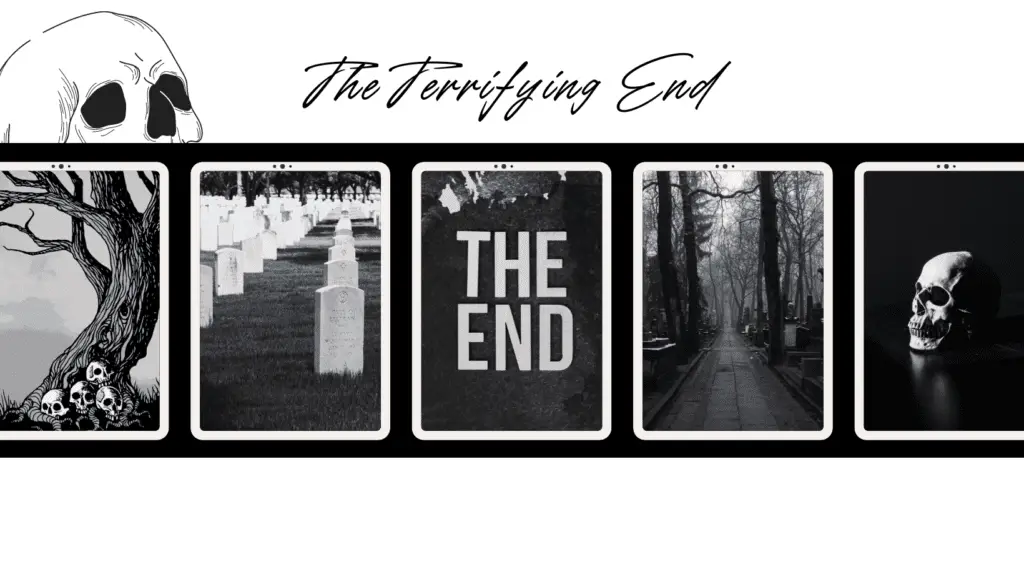
The Terrifying End
In this article, we’ve explored the basics of crafting terror in horror writing, delving into the psychology of fear, the importance of atmosphere, the art of crafting unsettling characters, the power of suspense, the use of unpredictability and surprise, the balance between gore and psychological horror, the significance of theme and subtext, and the value of learning from the masters of the genre. As you embark on your journey as a horror writer, keep these key points in mind:
- Understand the psychology of fear and terror to create immersive horror experiences.
- Establish a strong atmosphere and setting to build tension and unease.
- Develop multi-dimensional characters that evoke both sympathy and dread.
- Master the art of suspense through pacing, foreshadowing, and misdirection.
- Subvert expectations and create shocking twists using unpredictability and surprise.
- Balance gore and psychological horror to cater to different reader preferences.
- Explore deeper themes and subtext to elevate your horror stories.
- Study the works of influential horror authors to learn and apply their techniques.
Remember, the path to becoming a successful horror writer is paved with practice and experimentation. Don’t be afraid to explore different techniques, styles, and subgenres as you find your unique voice in the world of horror fiction. Embrace the challenge, and above all, enjoy the thrilling process of crafting terrifying stories that captivate and haunt your readers. With dedication, perseverance, and a keen understanding of the elements that make horror stories effective, you too, can leave your mark on the genre and create memorable, spine-chilling tales that linger long after the last page is turned.
- About the Author
- Latest Posts
Stuart Conover is a father, husband, published author, blogger, geek, entrepreneur, horror fanatic, and runs a few websites including Horror Tree!













